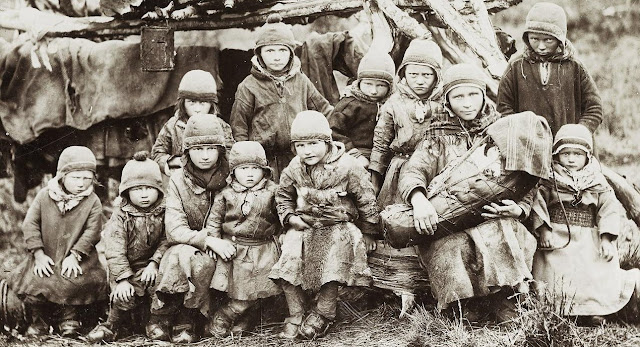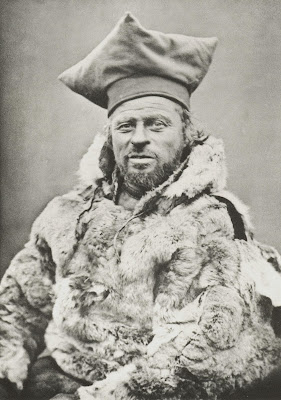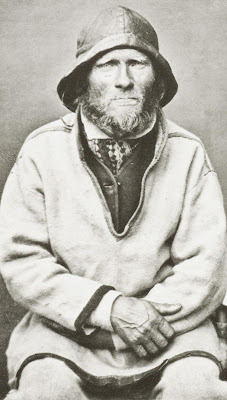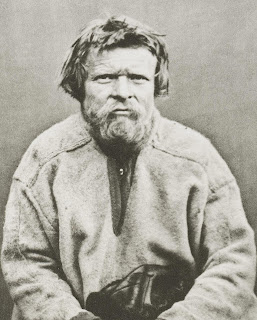 Map from Wikipedia, Public Domain Photo, GNU
Map from Wikipedia, Public Domain Photo, GNU Scanned postcard of a Tunisian Woman, sent in 1904
Scanned postcard of a Tunisian Woman, sent in 1904 Scanned antique postcard of an Moroccan man
Scanned antique postcard of an Moroccan man A study by Achilli et al.(2005) found a genetic link between the Saami people and the North-African Amazigh People. Instead of Berber I will use the term Amazigh (plural: Imazighen), since this is the name preferred by the indigenous people of North Africa.
The genetic connection of U5b1b [marker 309 C] is about 9000 years old and is shared between Saami from Scandinavia, Italians, Spanish, Amazigh, Yakut man from Siberia and Fulbe (Fulani) from Senegal.
Et studie av Achilli et al. (2005) fant en genetisk forbindelse mellom samene og det nordafrikanske Amazigh folket. Fordi urbefolkningen i nord Afrika foretrekker navnet ”Amazigh” (flertall Imazighen) fremfor Berber så skal jeg bruke det. Den genetiske forbindelsen i U5b1b [markøren 309 C] er omtrent 9000 år gammel og deles av Samene, Italienere, Spanjoler, Amazigh, Jakuter fra Sibir og Fulbe (Fulani) fra Senegal. I den følgende hyperlink kan du se et tre av haplogruppe U hentet fra artikkelen til Achilli et al. (2005). I linjene under der igjen kan du klikke på hyperlinkene for å se foto og artikler om de ulike folkene. Markørene som er listet i tabellen viser felles og ulike markører funnet hos 6 personer hvor 3 er samisk, 1 er fra Jakutia, 1 er Fulbe fra Senegal og 1 er Amazigh.
Tree of mtDNA sequences belonging to haplogroup U from the article of Achilli et al. (2005).
In the haplogroup tree of U5b1b:
Number 22 is Italian, 23 is Spanish, 24 is Italian, 25 is Saami, 26 is Saami, 27 is from Yakutia (Yakutiya), 28 is Saami, 29 is Fulani (1, 2, 3,4 and Fula) and 30 is Amazigh (1, 2, 3 and 4).

Couple in Egypt in the 1800eds.
The shared and discrepant markers in the Saami, Yakut, Fulbe and Amazigh people is as following:
U :.......3197, 9477, 13617, 16270 (all)
U5:.......150, 7768, 14182 (all)
U5b:......5656 (all)
U5b1:....16189, 7385, 10927, 12618 (all)
U5b1b:...16144, 309C, 1850, 16148, 16335 (Saami)
U5b1b:...16144, 309C, 14927 (Yakut)
U5b1b:...309C, 16192, 8413, 16320 (Fulbe)
U5b1b:...309C, 16192, 152, 2387, 4345, 8839 (Amazigh)
Tambets et.al (2004) noted that the U5b1b motif was identified in Morocco.
Haplogroup V is more frequent in the Imazighen populations than U5. Torroni et al. (2001), Bermisheva et al. (2002) and Tambets et al. (2004) pointed out that mtDNA V genes in the Saami very likely migrated from Central Europe via Eastern Europe and north-westwards. The Saami mtDNA V motif [16153, 16298] is more frequent in eastern than in western Europe.
Tambets et al. (2004) bemerket at U5b1b var identifisert i Marokko. Haplogruppe V er mer frekvent blant Imazighen folkene enn U5. Torroni et al. (2001), Bermisheva et al. (2002) og Tambets et al. (2004) hevdet at det mtDNA V genene til samene mest sannsynlig migrerte fra sentral Europa via Øst Europa og nordvestover. Det samiske mtDNA V motivet [ 16153, 16298]er mer frekvent i Øst Europa enn i Vest Europa.

The Map is borrowed from ”A Signal, from Human mtDNA, of Postglacial Recolonization in Europe” by Torroni et al. (2001) and the colours are inverted. The white show the extreme frequencies of V in the Saami. The Skolt Saami have 52% of mtDNA V, and it is observed in 12.4% of the Basque People in Iberia and in 6.1% of the Algerian Amazigh.
The diversity of haplogroup V is much higher in Iberia than in North Africa and therefore it is supposed that this haplogroup spread from Europe to the Imazighen as well as northwards to the Saami areas. The old genetic link in haplogroup U5b1b supports the hypothesis of early connections Amazigh – Iberia - Saami. Haplogroup U5b is very low frequently observed in the Imazighen populations.
I have added scientific articles (see references) for those who are interested in digging deeper into these subjects.
Kartet er lånt fra en artikkel av Torroni et al. (2001) og fargene er inverterte. Det hvite viser den ekstreme frekvensen av V hos samene. Skolt Samene har 52% med mtDNA V, og det er funnet hos 12.4% av Baskerne i Iberia og hos 6.1% av Amazigh folket i Algeria.
Diversiteten av haplogruppe V er mye høyere i Iberia enn i Nord Afrika og man antar derfor at denne haplogruppen spredte seg fra Europa til Imazighen folkene og også nordover til de samiske områdene. Den eldgamle genetiske forbindelsen i haplogruppe U5b1b støtter hypotesen om tidlige forbindelser mellom Amazigh – Iberia – Samene. Haplogruppe U5b er svært lavfrekvent hos Imazighen folkene.
Jeg har lagt ved lenker til ulike vitenskapelige artikler for de som ønsker å fordype seg i dette tema.
The following lecture neatly explains the mtDNA connection between the Amazigh People of North-Africa and the Saami People of Scandinavia and Kola.
”The genetics of the Finno-Ugric-speaking populations in Europe” by Toomas Kivisild (2005)
Denne forelesningen forklarer greit den genetiske mtDNA forbindelsen mellom Imazighen i Nord Afrika og samene. Den finnes kun på engelsk.
In a later blog I will comment on use of the term “Finn” and “Fenn” from “online Etymology dictionary” that is included in the lecture by Toomas Kivisild (2005).
I en senere blog skal jeg kommentere på bruken av benevnelsen ”Finn” og ”Fenn” fra ”online Ethymology dictionary” som er inkludert i denne forelesningen av Kivisild. .
 Great Atlas Mountains © Piccaya Dreamstime.com
Great Atlas Mountains © Piccaya Dreamstime.com Medenine in Tunisia: Traditional ksour ( Berber fortified Granary)© Jakezc Dreamstime.com
Medenine in Tunisia: Traditional ksour ( Berber fortified Granary)© Jakezc Dreamstime.comMtDNA in the Amazigh People:
“Our HLA data suggest that most Moroccans are of a Berber (Imazighen) origin and that Arabs who invaded North Africa and Spain in the 7th century A.D. did not substantially contributed to the gene pool; however, they imposed their advanced culture and their religion.” Quoted from the Abstract: ”HLA genes in Arabic-speaking Moroccans: close relatedness to Berbers and Iberians” by Go´mez-Casado, 1999
Maca-Meyer et al. (2001) observed mtDNA V and U5b [16189, 16192, 16270] in the Imazighen: “the arrival of Caucasoids by the existence of a subclade of haplogroup U that, today, is mainly confined to Northwest Africa” (end of quote).
Macaulay et al. (1999) observed the following motifs of haplogroup V in Imazighen populations: 12 + 30 with [16298], 29 with [16153, 16298] and 4 with [16189, 16298].
Cerneý et al. (2006) found nearly 80% African haplogroups L1, L2 and L3 and in total 8.1% of western Eurasian haplogroups J1b, U5, H and V in sub-Saharan Fulani people.
The Cuanches seem to be descendants of the Imazighen people of North Africa. Maca-Meyer et al. (2004) reported 4.23% of mtDNA V in ancient Guanches and 2.33% in the present populations of both mtDNA V and U5b on the Canary Islands. The ancient Guances had a frequency over 10% and the present population on the Canary Islands population over 30% of MtDNA U6.
Rando et al. (1998) reported haplogroup U in 10% of North Africans, but the exact subgroup was not given except that it was not U6. The same study found 4.1 % mtDNA V in North Africans (see Brehm et al. 2003).
MtDNA haplogroup U5 was found in 6% and V [16298] in 10% of the Souss population in Morocco (Brakez et al. 2001).
 Map: Photo Courtesy NASA JPL-Caltech. My colouring and illustrations in blue, white and black.
Map: Photo Courtesy NASA JPL-Caltech. My colouring and illustrations in blue, white and black.  Map: Photo Courtesy NASA JPL-Caltech, my colouring and illustrations in blue, white and black.
Map: Photo Courtesy NASA JPL-Caltech, my colouring and illustrations in blue, white and black.These two maps illustrate my understanding of the genetic migrations of two cold adapted haplogroups U5 and V. That mtDNA U5 and V are cold adapted makes it very likely that they were present in Europe during the Last Ice Age. The following archaeological findings are shedding some light on the migrations of these two haplogroups.
De to kartene illustrerer min forståelse av de genetiske migrasjonene til de to kuldetilpassede haplogruppene U5 og V. At mtDNA U5 og V er kuldetilpasset gjør det svært sannsynlig at de var tilstede i Europa under den siste istid. Følgende funn er også med på å øke forståelsen av migrasjonene til disse to haplogruppene.
PowerPoint Lecture by Dr. Rum Kefi: MtDNA of ancient North Africans
MtDNA haplogroups J/T, H, L3, U, U6 and V are found in an ancient population (13000 -12000 years BP) discovered in the Taforalt Caves, Morocco. The HVR1 sequences of mtDNA V found was [16298] and [16179, 16298].
Over kan du klikke på lenken for å få en forelesning av Dr. Rum Kefi om eldgammelt mtNA i Nord Afrika. I en gammel populasjon (13000 – 12000 år) som ble funnet i Taforalt grottene i Marokko fant man haplogruppene J/T, H, L3, U, U6 og V. HVR1 sekvensene til mtDNA V var [16298] og [16179, 16298].
The remains of some 200 people of this microlithic period excavated from a cave at Taforalt in Morocco show few signs of violence, but they do show close interbreeding, high mortality among children and infants, and many routine miseries such as arthritis
Fritt oversatt fra følgende lenke: Etterlevningene til de 200 personer fra mikrolittisk periode som ble gravd frem i Taforalt grotten i Marokko viser ingen tegn på vold, men de viser omfattende inngifte, høy dødelighet blant barn og spedbarn, og mange rutinemessige plager som artritt.
Two persons from the Taforalt Caves with mtDNA V probably came with migrations southwards from western Europe to the areas of present Morocco. As mentioned in an earlier blog a new study by Kivisild et al. (2006) found that mtDNA V is adapted to the cold climates of Europe during the Last Ice Age and is of Northern European origin. Haplogroup J/T, H and U (depending on what subgroup of U) very likely came with migrations from the Middle East to the Amazigh and later migrated northwards. L3 came from Sub-Saharan areas in Africa.
”Diversité mitochondriale de la population de taforalt(12.000 ans bp - maroc): une approche génétique a l'étude du peuplement de l'afrique du nord” by Kéfi et al. 2005 (Abstract in English)
De to personene fra Taforalt grottene som hadde mtDNA V har sannsynligvis kommet med migrasjoner sørover fra vest Europa til dagens områder av Marokko. Som nevnt I en tidligere blog så viser et nytt studie av Kivisild et al. (2006) at mtDNA V er tilpasset det kalde klimaet i Europa under den siste istid og er av nord europeisk opprinnelse. Haplogruppene J/T, H og U (avhenging av hvilken undergruppe av U det her er snakk om) kom ganske sikkert fra Midtøsten til Amazighfolket og migrerte senere nordover. L3 kom fra områdene sør for Sahara.
 Kabyle Women from wikimedia, Commons public domain photo
Kabyle Women from wikimedia, Commons public domain photoReferences / Referanser:
A Signal, from Human mtDNA, of Postglacial Recolonization in Europe by Antonio Torroni et al. (2001). Am. J. Hum. Genet. 69:844–852, 2001
The Western and Eastern Roots of the Saami—the Story of Genetic “Outliers” Told by Mitochondrial DNA and Y Chromosomes by Kristiina Tambets et al. (2004). Am. J. Hum. Genet. 74:661–682, 2004
Saami and Berbers—An Unexpected Mitochondrial DNA Link by Alessandro Achilli et al. (2005). Am J Hum Genet. 2005 May; 76(5): 883–886.
Major genomic mitochondrial lineages delineate early human expansions by Nicole Maca-Meyer et al. (2001), BMC Genetics 2001, 2:13.
”The Emerging Tree of West Eurasian mtDNAs: A Synthesis of Control-Region Sequences and RFLPs” by Vincent Macaulay et al. 1999
”Mitochondrial DNA heterogeneity in Tunisian Berbers” by Fadhlaoui-Zid et al. 2004
”Genetic relationships among Berbers and South Spaniards based on CD4 microsatellite/Alu haplotypes” by Esteban et al. 2004
”Islands inside an island: reproductive isolates on Jerba island” by Loueslati et al. 2006
”Female gene pools of Berber and Arab neighboring communities in central Tunisia: microstructure of mtDNA variation in North Africa” by Cherni et al. 2005
”HLA genes in Arabic-speaking Moroccans: close relatedness to Berbers and Iberians” by Go´mez-Casado, 1999
“Our HLA data suggest that most Moroccans are of a Berber (Imazighen) origin and that Arabs who invaded North Africa and Spain in the 7th century A.D. did not substantially contributed to the gene pool; however, they imposed their advanced culture and their religion.” (Quoted from the Abstract).
”mtDNA of Fulani Nomads and Their Genetic Relationships to Neighboring Sedentary Populations” by Cerny et al. 2006
“mtDNA lineages in two Tunisian Berber communities: Comparing diversities between villages and towns” by Frigi et al. 2005
”Ancient mtDNA analysis and the origin of the Guanches” by Nicole Maca-Meyer, 2004
”African female heritage in Iberia: a reassessment of mtDNA lineage distribution in present times” by Pereira et al. 2005
”MtDNA Profile of West Africa Guineans: Towards a Better Understanding of the Senegambia Region” by Alexandra Rosa
”Mitochondrial DNA transit between West Asia and North Africa inferred from U6 phylogeography” by Nicole Maca-Meyer
”Mitochondrial portraits of the Madeira and Acores archipelagos witness different genetic pools of its settlers” by Brehm et al. 2003
Roots web: The Phoenician Hypothesis: An mtDNA Note re the phylogeographic occurances of mtDNA Haplotype U6b as related to the Results found in Mitochondrial DNA testing by Family Tree DNA of certain Kits, with reference to results posted in MitoSearch
”Human mitochondrial DNA sequence variation in the Moroccan population of the Souss area” by Brakez et al. 2001
Short about the Berber People
Roots of people in Senegambia
About the Fula,Foulah, Peulh, Peul, or Fulbe People
The Fulakunda of Senegal: Population size 492.000, Islam and language Pulaar
Fulba Jeeri, Fula Toro of Senegal: Population size 1.312.000, Islam and language Pulaar
Fula Jalon, Futa Fula of Senegal: Population size 150.000, Islam and language Pular
Amazigh people’s photo galleries
Amazigh archaeology
Amazigh History
Wikipedia: Berber People
Morphological Continuity of the Face in the Late Middle and Upper Pleistocene Hominins from North Western Africa – A 3-D Geometric
Morphometric Analysis” by Harvati and Hublin, 2007
”Africans: The History of a Continent”, Second Edition, by John Iliffe









